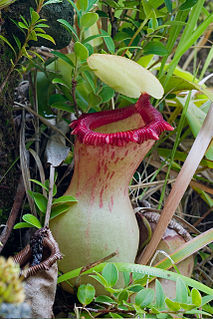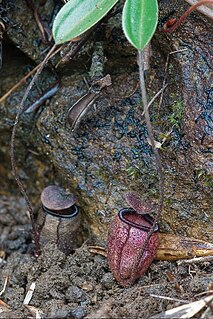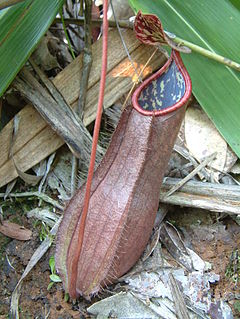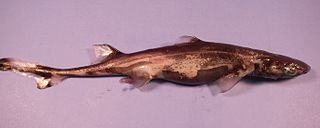
The shy albatross or shy mollymawk is a medium-sized albatross that breeds on three Australian islands and ranges across the southern Indian Ocean.

Nepenthes veitchii, or Veitch's pitcher-plant, is a Nepenthes species from the island of Borneo. The plant is widespread in north-western Borneo and can also be found in parts of Kalimantan. Nepenthes veitchii usually grows as an epiphyte, though the form from Bario seems to be strictly terrestrial and has not been observed to climb trees.

Nepenthes truncata is a tropical pitcher plant endemic to the Philippines. It is known from the islands of Dinagat, Leyte, and Mindanao. The species grows at an elevation of 0–1500 m above sea level. Nepenthes truncata is characterised by its heart-shaped (truncate) leaves and very large pitchers, which can reach up to 40 cm in height.

Nepenthes stenophylla, or the narrow-leaved pitcher-plant, is a tropical pitcher plant endemic to Borneo. The species produces attractive funnel-shaped pitchers up to 25 cm high. It is listed as Least Concern on the IUCN Red List. Nepenthes stenophylla belongs to the loosely defined "N. maxima complex", which also includes, among other species, N. boschiana, N. chaniana, N. epiphytica, N. eymae, N. faizaliana, N. fusca, N. klossii, N. maxima, N. platychila, and N. vogelii.

Nepenthes ventricosa is a tropical pitcher plant endemic to the Philippines, where it is a highland species, growing at an elevation of 1,000–2,000 metres (3,300–6,600 ft) above sea level. It has been recorded from the islands of Luzon, Panay, and Sibuyan. The pitchers are numerous, growing up to 20 centimetres (8 in) tall and ranging in colour from ivory white to red.

Nepenthes gymnamphora is a tropical pitcher plant native to the Indonesian islands of Java and Sumatra. It has a wide altitudinal range of 600–2,800 metres (2,000–9,200 ft) above sea level. There is much debate surrounding the taxonomic status of this species and the taxa N. pectinata and N. xiphioides.

Nepenthes argentii is a highland Nepenthes pitcher plant native to Mount Guiting-Guiting on Sibuyan Island in the Philippines. It is possibly the smallest species in the genus and does not appear to have a climbing stage.

Nepenthes ramispina is a highland Nepenthes pitcher plant species, native to Peninsular Malaysia. It was once regarded as being similar to N. gracillima, but studies of the two species in nature have shown that they are readily distinguishable in isolation, N. gracillima being far more readily confused with N. macfarlanei in its rosette stage.

Nepenthes tomoriana is a species of pitcher plant endemic to Sulawesi, where it grows at an elevation of 0–500 m above sea level.

Nepenthes deaniana is a tropical pitcher plant endemic to the Philippines, where it grows at an altitude of 1180–1296 m above sea level. The species is known only from the summit region of Thumb Peak, a relatively small, ultramafic mountain in Puerto Princesa Province, Palawan.

Etmopterus is a genus of lantern sharks in the squaliform family Etmopteridae. They are found in deep sea ecosystems of the Atlantic, Indian and Pacific Oceans.

Periglypta is a genus of bivalves in the family Veneridae.
Trechus aduncus is a species of ground beetle in the subfamily Trechinae. It was described by Barr in 1962. There is no subspecies listed in the Catalogue of Life.
Alfred Frank Millidge was a British arachnologist who wrote several works on spiders. One of his best-known might be British Spiders, volumes I and II, which he co-wrote with G. H. Locket. In 1983, he became the first person to describe the spider species Walckenaeria crocea.

Araneus viridiventris is a species of spiders described by Takeo Yaginuma in 1969, found in China, Taiwan, and Japan. Araneus viridiventris is included in the genus Araneus, and in the family Araneidae. No subspecies are listed.

Isocrinidae is one of four extant families of crinoids in the order Isocrinida. It has three genera.
Odorrana indeprensa is a true frog species in the family Ranidae, described first by Bain and Stuart 2006.
Glyptothorax annandalei is a species of catfish that was first described by Hora in 1923. Glyptothorax annandalei is a species in genus Glyptothorax, family Sisoridae and order Siluriformes. IUCN categorise the species as least concern globally. No subspecies are listed in Catalogue of Life.
Pardosa pullata is a species of spiders from Pardosa genus, Lycosidae family. Was described by Alexander, in 1757.

Panulirus gracilis, the green spiny lobster, is a crustacean species described by Thomas Hale Streets 1871. Panulirus gracilis is part of the genus Panulirus and the Palinuridae family. IUCN categorizes the species globally as insufficiently studied. No subspecies are listed in the Catalog of Life.















